In the ongoing debate about school uniforms, a significant voice often goes unheard – that of the students themselves. The argument against mandatory school uniforms is not just about fashion or personal preferences; it delves deeper into fundamental issues of self-expression, equity, and the very purpose of education. This article, “Why Students Should Not Wear Uniforms,” seeks to uncover the less discussed but crucial aspects of this debate, presenting a comprehensive view that challenges the traditional perspective favoring uniforms.
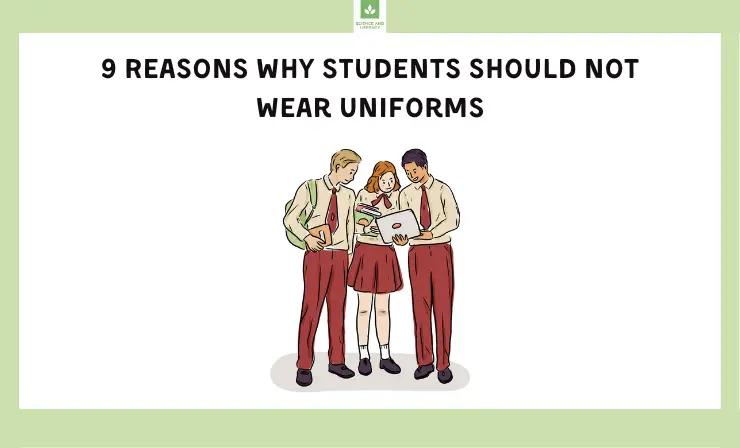
At the core of the anti-uniform stance is the belief in the importance of individuality and personal growth during the formative years of schooling. Uniforms, often seen as a tool for homogenization, can stifle the self-expression and creativity that are essential in nurturing young minds. By enforcing a standard mode of dress, schools may inadvertently suppress the diversity and individuality that should be celebrated within educational environments. Moreover, the imposition of uniforms can raise significant financial burdens for families, create unnecessary resistance to authority, and overlook important cultural and religious considerations.
I am seething about this poor young girl who has been put in isolation because she’s not wearing a school uniform bought from the right place, school uniforms are far too expensive for a lot of people in this country in the most ridiculous you can get just as good from supermarke
— James Whale (@THEJamesWhale) September 17, 2023
This article aims to explore these perspectives, offering insights into why the policy of mandatory school uniforms might be an outdated approach that overlooks the broader objectives of education and personal development. As we delve into this topic, we invite readers to reconsider the conventional wisdom on school uniforms and reflect on the potential benefits of a more flexible and inclusive approach to student attire.
After reading this article you’ll know:
- Educator and Industry Expert Perspectives →
- 9 Reasons Why Students Should Not Wear Uniforms →
- Opposing Perspectives on School Uniforms →
Uniforms in Education: Educator and Industry Expert Perspectives
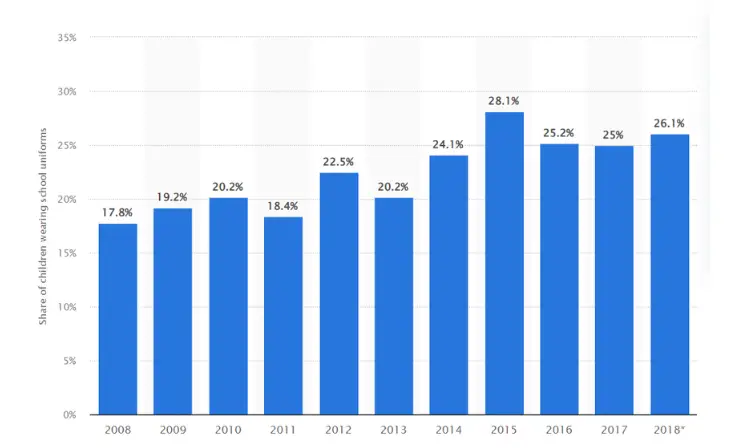
Teachers and educational experts are increasingly questioning the rising trend of school uniforms in U.S. public schools. While the period from 1999-2000 to 2017-18 saw an increase from 12% to 20% in schools adopting uniforms, there’s growing concern about their impact on student individuality and expression. In 2015-2016, uniform policies were enforced in 25% of public primary schools, 20% of middle schools, and 12% of high schools, with a notable prevalence in urban and high-poverty schools. Experts argue that such policies, while aiming for uniformity, might inadvertently suppress student creativity and self-identity, vital for holistic educational development.
Here’s the perspective of educational field experts on the matter:
“I completely disagree with uniforms on every level. Supporters of uniforms say that they reduce bullying with regards to fashion, but there is a great deal of evidence that says it just pushes that bullying underground. Instead of being bullied about something superficial like the shirt you are wearing, bullies just go to the tried and true body image shaming. Glass? Overweight? Acne? Too many freckles? Hair colour? Too tall? Too short? What school administrators see is a surface level reduction in bullying, followed by them patting themselves on the back and ignoring the problem completely.”
“While uniforms are supposed to build a sense of community, they may have the opposite effect. Fashion is one way that students express themselves, and that may be an important part of the school experience. When students can’t show their individuality, they may not feel like they belong as much. School uniforms may not be the most effective way to improve student behavior and engagement.”
“I really don’t care whether or not a student’s shirt is tucked in, as long as they are learning. I don’t care whether or not a student has on the right belt, as long as I can’t see their underwear. I don’t care if a boy has earrings, facial hair, or painted nails, as long as he’s not painting them in my class. I don’t care if a girl has bright pink hair, a tank top, and ripped jeans, as long as bosoms and butt cheeks are covered and secure. I don’t like hoodies on heads in my classroom because it makes it too easy to hide Airpods, but I don’t care if the sweatshirt has a hood. As long as it’s not a top hat or sombrero that blocks the view of the students behind them, I don’t care if my students wear hats or beanies in my class.”
The video below explores the debate on the impact of school uniforms on academic performance. It delves into whether mandating uniforms in schools truly enhances students’ learning and overall academic success.
Want to know how to be a strict teacher? Read our dedicated article.
9 Reasons Why Students Should Not Wear Uniforms
Let’s explore the reasons against mandating school uniforms for students. Understanding these arguments provides valuable insights into the broader educational and social implications of uniform policies.
1. Expression of Individuality
The concept of “Expression of Individuality” in the context of school uniforms is a vital aspect of student development and autonomy. When schools impose uniforms, they inadvertently restrict a key channel through which students express their individuality and creativity. This freedom of expression is not merely about fashion or aesthetics; it’s a crucial part of a student’s journey towards self-discovery and confidence building.
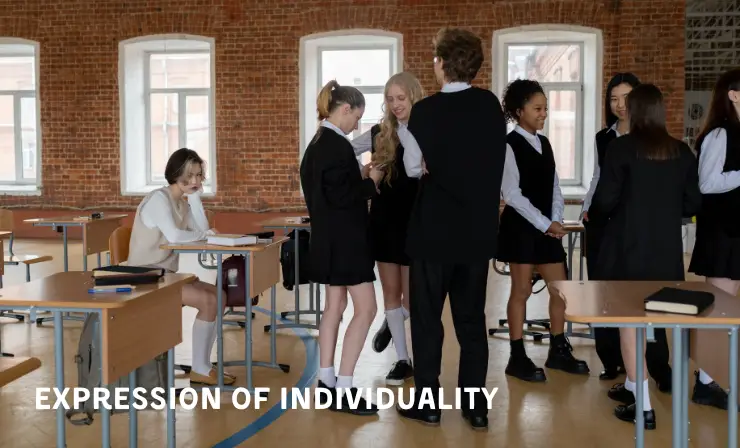
Key aspects of individuality expression through clothing include:
- Personal Identity Formation: Choosing what to wear allows students to explore and affirm their personal identities and tastes.
- Creativity and Innovation: Fashion is a form of art. Allowing students to select their own clothes fosters creativity and innovation, skills highly valued in many aspects of life and work.
- Cultural Expression and Diversity: Clothing can be a powerful expression of cultural heritage. A diverse dress code celebrates and acknowledges the rich tapestry of cultures in the student body.
Beyond these points, individuality in clothing choices helps prepare students for future environments where they must make decisions about their personal and professional presentation. In many modern workplaces, the ability to express oneself appropriately through attire is valued and can impact career progression and personal branding.
Furthermore, enforcing a uniform policy can subtly imply that conformity is more important than individual thought and expression. This is at odds with the educational goal of fostering independent, critical thinkers who will contribute uniquely to society.
In essence, the freedom to choose one’s attire is not just a matter of personal taste but a crucial element in nurturing confident, creative, and culturally aware individuals. Schools, by embracing this diversity in student clothing, can enhance the educational experience and better prepare students for the varied and diverse world beyond their gates.
2. Financial Burden
The requirement of school uniforms can impose a significant financial burden on families, an aspect that often gets overlooked in the uniform policy debate. In the United States, over half of parents, at 55%, perceive school uniforms to be costly. This financial strain is not just about the initial cost of purchasing uniforms, but also encompasses several hidden expenses that accumulate over time.
Key points illustrating the financial burden of school uniforms include:
- Initial and Replacement Costs: Uniforms, especially those with specific designs or logos, can be expensive to buy. Additionally, as children grow or uniforms wear out, they often need replacing, adding to the financial strain.
- Multiple Sets Requirement: To maintain a clean and presentable appearance throughout the week, families typically need to purchase multiple sets of uniforms, further escalating the cost.
- Special Care and Maintenance: Some uniforms require special laundering or care, which can add to the overall expense, either in terms of higher home utility bills or professional cleaning services.
Moreover, these costs can be particularly burdensome for families with multiple children or those on a limited income. Research from the University of York highlighted that school uniforms present unmanageable costs for low-income families. The study found that purchasing uniforms imposed sudden and significant financial burdens, leading families to make sacrifices on essentials like food and heating, and in some cases, to enter into debt.
In addition to the direct financial impact, there’s also the consideration of opportunity cost. Money spent on uniforms could have been allocated to educational resources, extracurricular activities, or savings for future educational expenses.
In conclusion, the mandatory school uniform policy can lead to significant and often underappreciated financial pressures on families, making it a substantial reason for reconsidering such policies, especially in schools that serve economically diverse or disadvantaged communities.
3. Comfort and Practicality
The issue of comfort and practicality is a significant concern in the debate against mandatory school uniforms. Students spend a substantial part of their day in school, and their attire plays a crucial role in their overall comfort and ability to engage effectively in various school activities.
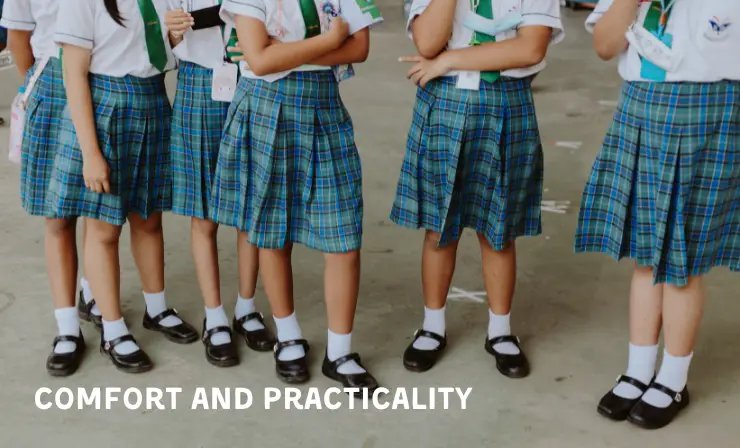
Key aspects highlighting the importance of comfort and practicality include:
- Physical Comfort: Uniforms, often designed with a one-size-fits-all approach, may not suit every body type, leading to discomfort. Comfortable clothing is essential for students to focus and participate actively in their learning.
- Suitability for Varied Activities: School life involves a range of activities, from sitting in classrooms to physical education and outdoor play. Uniforms might not be practical for all these diverse activities, impacting students’ ability to participate fully.
- Weather Appropriateness: Uniforms may not be designed for all weather conditions, which can affect students’ comfort and health. For example, a uniform might be too warm for summer months or insufficiently protective during colder weather.
Additionally, practicality concerns extend to the maintenance of uniforms. They often require regular washing and ironing, which can be time-consuming for families. Also, the need for specific uniform attire for different school events or days (e.g., physical education uniforms) adds to the complexity and impracticality of the uniform system.
In essence, prioritizing comfort and practicality in student attire is not only a matter of convenience but also impacts their academic engagement and well-being. Allowing students to wear clothing that is comfortable, suited to a variety of activities, and appropriate for the weather can enhance their school experience, making them more receptive to learning and participating in school life.
4. Lack of Preparation for Real World
The argument that school uniforms do not adequately prepare students for the ‘real world’ is increasingly relevant in today’s diverse and flexible professional environment. In many modern workplaces, the ability to choose and present oneself appropriately is a valued skill, reflecting individual judgment and adaptability.
Key points underscoring this lack of preparation include:
- Diversity in Workplace Attire: Modern workplaces often have varied dress codes, ranging from formal to casual. Uniform policies do not expose students to the decision-making process involved in dressing for different occasions and environments.
- Personal Branding: In many careers, personal style is an integral part of professional branding. Uniforms do not allow students to explore and develop their personal style, which can be a disadvantage in professions where self-presentation is key.
- Adaptability and Decision-Making: Choosing appropriate attire for different settings teaches adaptability and decision-making skills. Uniforms eliminate these daily choices, potentially leaving students less prepared to make such judgments post-graduation.
Norman Isaacs, the principal at Millikan Middle School in Sherman Oaks, California, opposes school uniforms. He argues that students should be taught to make decisions and choices rooted in their own values instead of adhering to arbitrary rules. He believes this approach is essential for students to develop independent thinking and self-discipline.
In conclusion, while uniforms might simplify wardrobe decisions during school years, they can inadvertently hinder the development of skills necessary for navigating the varied and often nuanced dress codes encountered in adult life, especially in professional settings. Allowing students the freedom to choose their attire is more aligned with preparing them for the real-world scenarios they will face after graduation.
5. Equality Issues
The topic of equality in relation to school uniforms is multi-faceted and complex. While uniforms are often championed as a tool for promoting equality, they can, in fact, inadvertently highlight and exacerbate existing socioeconomic disparities among students.
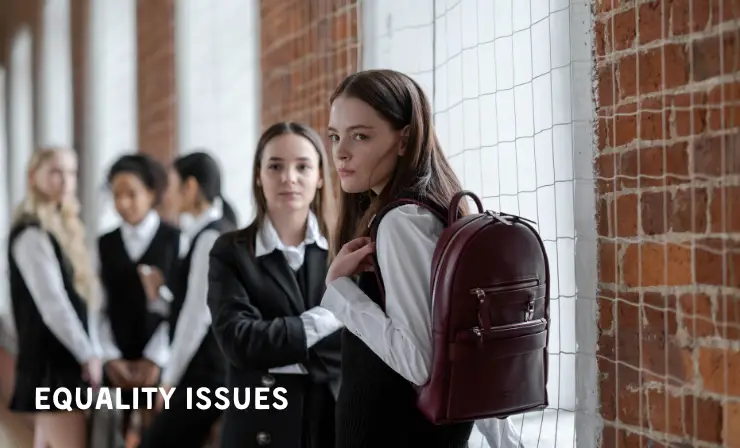
Key points illustrating the equality issues associated with school uniforms include:
- Highlighting Economic Disparities: The quality, newness, and upkeep of uniforms can become a marker of economic status. Students from less affluent backgrounds may struggle to keep their uniforms in pristine condition, inadvertently highlighting socio-economic differences.
- Access to Uniforms: The cost of uniforms can be prohibitive for some families, particularly those with multiple school-age children, leading to inequality in access.
- Uniform Assistance Programs: While some schools offer uniform assistance programs, reliance on such programs can inadvertently stigmatize students, creating a sense of otherness rather than unity.
Moreover, the notion that uniforms inherently promote a sense of equality among students is debatable. While uniforms may superficially level the playing field by unifying student attire, true equality and respect among students stem from an inclusive school culture that values diversity, not just from masking individual differences with standard clothing. For example, in schools like Archer, the uniform policy doesn’t restrict branded shoes or accessories, allowing students to display wealth through these items. This often leads to a sense of inequality, as students become aware of and feel pressured by the presence of expensive items, undermining the supposed leveling effect of uniforms.
In summary, while the intention behind school uniforms may be to create a level playing field, they can sometimes have the opposite effect by highlighting economic disparities and creating barriers to access. A more effective approach to promoting equality in schools involves addressing these deeper issues directly, rather than masking them with a uniform policy.
6. Resistance to Authority
The imposition of school uniforms can sometimes foster resistance to authority among students, particularly as they grow older and seek to assert their independence and individuality. This resistance is not just a matter of rebellion; it often stems from deeper feelings of autonomy and self-expression being suppressed.
Key points related to resistance to authority include:
- Asserting Independence: As children mature into teenagers, they naturally seek to express their individuality. Uniforms can be perceived as a restriction on this expression, leading to resistance as a form of asserting independence.
- Questioning Rules and Uniformity: Older students often begin to question the rationale behind various rules, including dress codes. Mandatory uniforms can become a focal point of this questioning, symbolizing a broader struggle against perceived unnecessary authority.
- Impact on Student-Teacher Relationships: Strict uniform policies can create an adversarial dynamic between students and school authorities, impacting the overall school environment and student-teacher relationships.
The resistance to uniforms and, by extension, to school authority, can have wider implications. It can detract from the educational experience, creating an environment of conflict and tension rather than one of learning and growth. Additionally, this resistance can carry over into other aspects of school life, affecting participation in school activities, respect for school rules, and overall school morale.
In essence, while the aim of school uniforms may be to promote discipline and unity, they can sometimes yield the opposite result, particularly among older students. Recognizing and respecting students’ growing need for self-expression and autonomy is crucial in fostering a positive and productive school atmosphere.
7. Cultural and Religious Concerns
Addressing cultural and religious concerns is crucial when considering the impact of mandatory school uniforms. Uniform policies can sometimes conflict with students’ cultural and religious practices, leading to feelings of exclusion and a lack of representation.
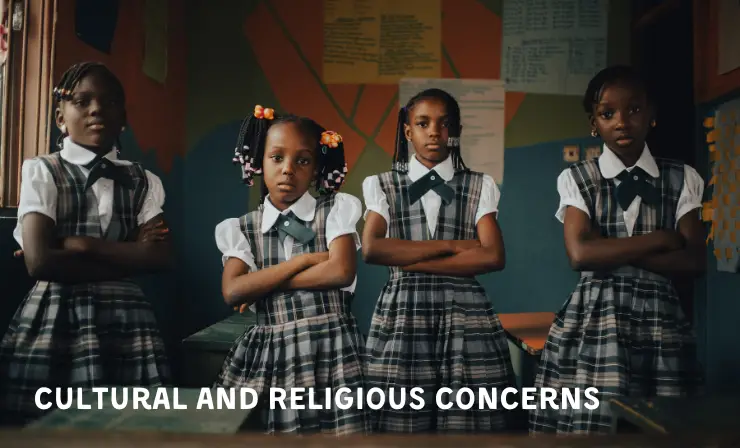
Key points highlighting cultural and religious concerns include:
- Respect for Cultural Attire: Many cultures have traditional attire that holds significant meaning. Uniform policies can prevent students from wearing these culturally important garments, leading to a loss of cultural expression.
- Accommodating Religious Dress Requirements: Some religions have specific dress codes, such as headscarves or particular garments. Uniforms that don’t accommodate these requirements can impede religious freedom and expression.
- Impact on Inclusivity and Diversity: A uniform policy that doesn’t consider cultural and religious diversity can create an environment where students feel their identities are not acknowledged or respected.
Furthermore, navigating these cultural and religious nuances requires sensitivity and understanding from educational institutions. When schools fail to accommodate such diversity, it can lead to a sense of alienation among students from different cultural or religious backgrounds. This alienation can affect their sense of belonging and engagement within the school community.
In summary, while school uniforms are often intended to create a cohesive and unified appearance, they can inadvertently undermine the rich cultural and religious diversity within the student body. An inclusive approach that respects and accommodates these differences is essential for fostering an educational environment that values and celebrates diversity.
8. Psychological Impact
The psychological impact of school uniforms on students is an important aspect to consider, particularly as it pertains to their self-image, confidence, and overall mental well-being. Uniforms, by their very nature of imposing a standard appearance, can have various unintended negative psychological effects on students.
Key points regarding the psychological impact include:
- Self-Image and Confidence: Uniforms can affect how students perceive themselves, especially if they feel the uniform is unflattering or doesn’t reflect their identity. This can lead to issues with self-esteem and confidence.
- Conformity vs. Individuality: The emphasis on conformity through uniforms may conflict with a student’s desire for individual expression, leading to internal conflict and stress.
- Stress on Families: The pressure to maintain a set standard of uniform can also place stress on families, particularly if they struggle financially or have time constraints, affecting the student’s home life and mental well-being.
Additionally, unflattering or restrictive uniforms can deter students from participating in sports, creating a psychological barrier. For example, an auto-ethnography highlighted the psychological barrier posed by an unflattering sports uniform to fat children’s participation in and enjoyment of physical activity.
In conclusion, while uniforms are often intended to eliminate distractions and create equality, they can have significant psychological impacts on students. These impacts can range from affecting self-esteem and personal identity to creating stress and anxiety. Considering these factors is crucial in evaluating the overall effectiveness and appropriateness of uniform policies in schools.
9. Not Environmentally Friendly
The environmental impact of school uniforms is an often overlooked yet critical aspect of the debate surrounding their use. The production, maintenance, and disposal of school uniforms carry significant environmental implications, making them a less sustainable option for student attire.
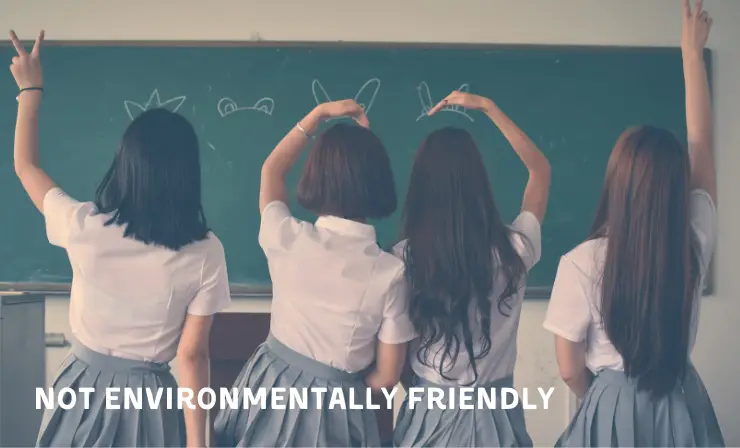
Key points highlighting the environmental concerns include:
- Resource-Intensive Production: The manufacturing of uniforms often involves resource-intensive processes, using materials that are not environmentally friendly and consuming large amounts of water and energy.
- Frequent Replacement and Waste: As children grow, uniforms need frequent replacing, contributing to textile waste. Unlike everyday clothing, which can be handed down or repurposed, specific school uniforms have limited use beyond the school environment.
- Chemical Usage in Maintenance: The maintenance of uniforms, especially those requiring special care, can involve the use of harsh chemicals and detergents, further contributing to environmental harm.
Furthermore, the environmental impact of uniforms extends beyond their production and maintenance. The disposal of outdated or worn-out uniforms poses a challenge, as they are often not made from biodegradable or recyclable materials, adding to landfill waste.
In summary, considering the environmental footprint of school uniforms is essential in the context of growing concerns about sustainability and environmental conservation. Moving towards more eco-friendly clothing options or implementing uniform recycling programs could be steps in mitigating the environmental impact associated with school uniforms.
Addressing Opposing Perspectives on School Uniforms
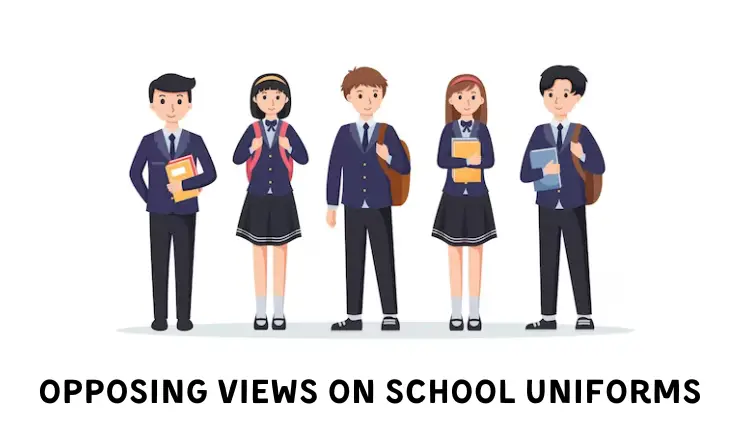
While the debate around school uniforms has varying opinions, it’s essential to consider the opposing views. Below, we explore common arguments in favor of mandating school uniforms, coupled with counterarguments that provide a different perspective on the issue.
1. Uniforms Save Time
The perceived time-saving aspect of school uniforms is often debated. While it’s argued that uniforms can save time in choosing outfits for school, this benefit is minimal as students still need casual attire for outside school hours.
Furthermore, uniforms can actually add to the workload of teachers. They often spend a significant amount of time enforcing uniform policies and addressing infractions such as improper dress. This enforcement can detract from the primary focus of teaching and reduce the time available for actual lesson delivery.
2. Uniforms Improve Attendance and Discipline
Proponents of school uniforms often claim they instill discipline by requiring students to adhere to dress codes. However, true discipline is more effectively cultivated through internal motivation and understanding the reasons behind rules, rather than mere conformity to a uniform. Encouraging critical thinking and self-discipline is more beneficial for students’ overall development.
This perspective is supported by research using data from the Early Childhood Longitudinal Study, which showed that school uniforms had no effect on students’ behavior across various dimensions, including internalizing and externalizing behavior problems, and social skills. This finding was consistent through kindergarten to the end of fifth grade, even after accounting for a range of factors that could influence behavior.
3. Improving Safety and Security
The argument that uniforms aid in identifying who belongs on campus and enhance security is subject to debate. While it may assist in spotting intruders, a more effective approach to safety involves a robust security system and active community engagement.
Fostering a safe school environment is better achieved through open communication and trust among students, staff, and the community. The effectiveness of uniforms in improving security is not universally acknowledged and is often viewed as a measure to enforce conformity rather than a genuine strategy to enhance safety.
Interested in exploring different teaching methods? Take a look at our comprehensive guide featuring 15 distinct teaching styles.
Useful Resources
- National Center for Education Statistics
- School uniforms: A history of ‘rebellion and conformity’ by BBC
- Educational Statistics by Statista
Conclusion
The case against school uniforms is compelling. Uniforms often fail to achieve their intended goals of promoting equality, saving time, and enhancing safety. Instead, they may inadvertently perpetuate socioeconomic disparities, add burdens to educators and students alike, and provide a false sense of security. Emphasizing personal expression, fostering genuine equality, and focusing on more effective educational strategies would be more beneficial for student development and school environments.
If you want to learn more about dress code for teachers, check out our article “How to Meet the Teacher Dress Codes in Diverse Learning Environments in 2023″.
References
- “Back-to-school: share of children wearing school uniforms in the United States from 2008 to 2018”, Statista
- “School uniforms”, National Center for Educational Statistics
- “Dressed for Success? The Effect of School Uniforms on Student Achievement and Behavior”, National Bureau of Economic Research
- “Do you think students need to wear a school uniform? Why or why not?”, Quora
- Department of Human Sciences, The Ohio State University
- “Dress Code, Stress Mode: A Teacher’s Perspective on the Uniform Debate”, New Orleans Mom
- “School Uniforms Are Expensive Statistics [Fresh Research]”, Gitnux
- “Buying school uniform post-lockdown ‘unmanageable’ for low income families”, phys.org
- “School Uniforms: Do They Reduce Violence–Or Just Make Us Feel Better?”, EdWeek
- “Do uniforms really create socioeconomic equity?: Designer items while in uniform”, The Oracle
- “Reviewing School Uniform through a Public Health Lens: Evidence about the Impacts of School Uniform on Education and Health”, Public Health Reviews
- “School uniforms save time”, Parlia
- “Early Childhood Longitudinal Program (ECLS)”, National Center for Educational Statistics
- “School Uniforms: A Safety and Security Issue”. The Raider Voice
- Overview of 22 Low-Code Agencies for MVP, Web, or Mobile App Development - October 23, 2024
- Tips to Inspire Your Young Child to Pursue a Career in Nursing - July 24, 2024
- How Parents Can Advocate for Their Children’s Journey into Forensic Nursing - July 24, 2024
